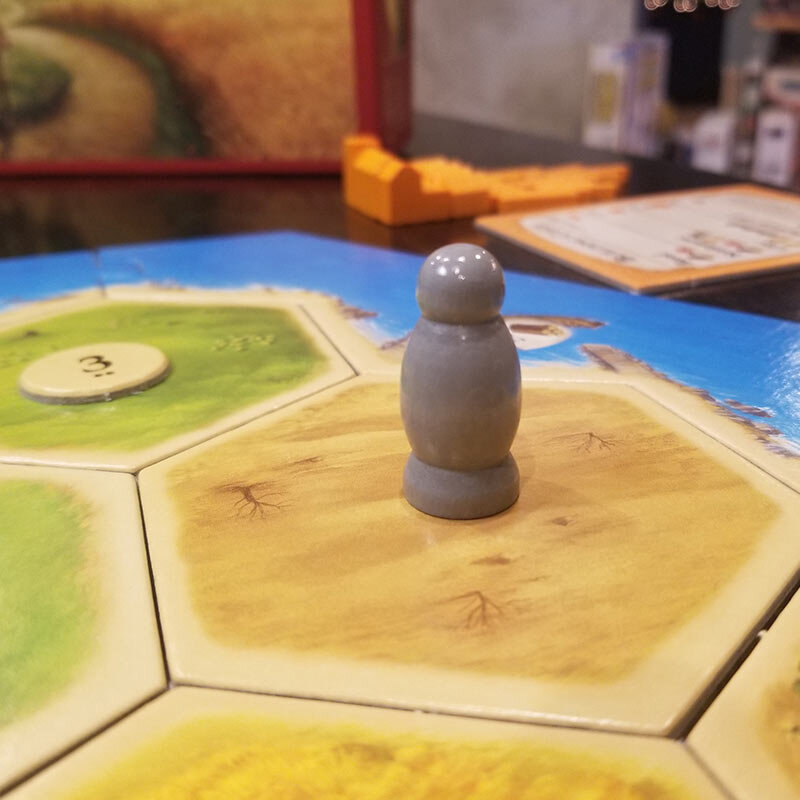Anybody Have Any Wheat? A Preview of Catan
SUMMARY:
Ages: 10+
Players: 3-4
Est. Length: 60-120 Minutes
Game Design: Klaus Teuber
Illustration: Volkan Baga
Publisher: Catan Studio, Inc.
Genre: Family
Mechanics: Dice Rolling, Modular Board, Trading, Route Building
Reviewer: Lex Judge
INTRODUCTION
Whenever I mention to anybody that I’m a lover of board games, one of two things usually happens: their eyes glaze over until I change the subject, or they say “oh like Catan? I love Catan!” This is for good reason. Since its release 25 years ago, Catan has been one of the most popular games to introduce people into the hobby.
Published in 1995 by Klaus Teuber, Catan has sold more than 32 million copies worldwide, and according to their website, approximately 20 million people regularly spend time in the Catan gaming universe, making Catan more than just a “gateway” or “entry” board game. It has won many awards, including the Spiel des Jahres Game of the Year award, one of the most prestigious awards a board game can earn. But is this highly acclaimed and popular game right for you?
In Catan, players spend their turns establishing settlements on the island of Catan. The island is made up of hexagonal tiles, each one having a number tile (2-12) and a resource printed on it. The players build their settlements in between these tiles, as well as cities and roads to connect them. At the beginning of every player’s turn, they will roll two standard six-sided dice, and add the results together. Whoever has any settlements or cities touching a hex tile with that number on it, receives one card matching the resource shown on the tile. This is the main way to gain resources in the game, but if the dice aren’t rolling your way, you are encouraged to trade with others to get the resources you need to build roads, settlements, and cities during your turn.
The goal of the game is to reach ten victory points, and players score one victory point for each settlement they have built, as well as two for each city. Players can also use their resources to buy development cards, which either have various effects or are worth victory points when earned. When a player reaches 10 victory points, the game ends immediately and that player is declared the winner.
THE MOMENT THE GAME “CLICKED”
Unlike watching television or reading a book, board games inherently have a learning curve. Every time you want to play a new game, you first have to learn how to play it. Games vary in difficulty and complexity, but every game has a moment where it just “clicks”. Once this moment happens, you’re able to fully grasp how the game is played, and what the goal is. This moment happens at different times for different people, but having an idea of when it can happen is a good indicator of whether or not you’ll enjoy learning and playing a game.
Catan was one of the first modern board games I ever played, back in those innocent days when I had no idea what a “Euro” game was, or any idea of how far modern strategy games have come. Despite having very little experience, I was able to pick it up after a single game, and felt I had a pretty firm grasp on the rules even after the first few turns. It’s helpful to play this game with someone who knows the rules very well, but the rulebook is also formatted well for beginners to pick up and play.
SHOULD YOU PLAY IT?
All of the copies sold and numerous awards won should speak for themselves, but I will definitively state it: yes, you should play Catan if you haven’t had the chance to do so already. The game offers a great mix of luck and strategy, and the trading aspect is reminiscent of making deals in Monopoly, without the backstabbing and heartbreak. The simplicity of what you do on your turn is what makes Catan a good “entry” or “gateway” game, and a perfect game to play with family and friends of varied ages and experience levels.
Speaking of Monopoly, the two aspects that I don’t like about Catan are traits that they share. The first being the heavy impact that luck plays in terms of dice rolling, with no real way to mitigate that luck. The second being the end of the game can take a while to achieve. You never really know how long a game of Catan will take, and sometimes it can overstay its welcome depending on the number of players and their skill level. These two aspects don’t bother me enough to dislike the game overall, and I am always willing to play it with those who enjoy it.
Catan makes a great holiday present for families, as well as expansions that allow you to play with more people and add interesting mechanics to the game. There are also stand alone sequels to the game, such as Catan Seafarers, and Star Trek Catan.
Hitherto also has a special 25th Anniversary Edition, available for a limited time, which comes with expansions included, as well as game trays that organize and hold the components for storage and gameplay. This version makes a great gift for anybody you know who loves Catan and doesn’t own it already, or anyone whose copy is looking a bit worse for wear and needs a fresh one!
Happy Gaming!












